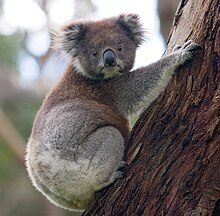

| Vombatiformes
Temporal range: Late Oligocene - Recent
| |
|---|---|

| |
| Phascolarctos cinereus | |
| Scientific classification | |
| Domain: | Eukaryota |
| Kingdom: | Animalia |
| Phylum: | Chordata |
| Class: | Mammalia |
| Infraclass: | Marsupialia |
| Order: | Diprotodontia |
| Suborder: | Vombatiformes Burnett, 1830 |
| Families | |
| |
The Vombatiformes are one of the three suborders of the large marsupial order Diprotodontia. Seven of the nine known families within this suborder are extinct; only the families Phascolarctidae, with the koala, and Vombatidae, with three extant species of wombat, survive.
Among the extinct families are the Diprotodontidae, which includes the rhinoceros sized Diprotodon, believed to be the largest marsupials ever, as well as the "marsupial lions" Thylacoleonidae and "marsupial tapirs" Palorchestidae.
Suborder Vombatiformes
|
| ||||||||||||||||||||||||||||
|---|---|---|---|---|---|---|---|---|---|---|---|---|---|---|---|---|---|---|---|---|---|---|---|---|---|---|---|---|
| ||||||||||||||||||||||||||||
| ||||||||||||||||||||||||||||
| Vombatiformes |
|
|---|---|